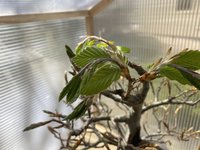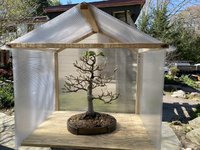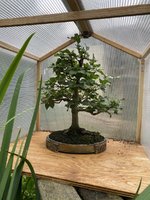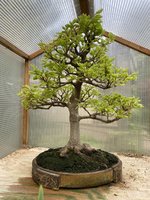Well......Admin at Holden Arboretum had a different opinion than the staff about starting a bonsai collection......so it's back in my possession .


However, they think it can be cured by interrupting the life cycle of the nematode. It's possible since the tree is in pot and can be moved.
They've discovered the nematode lives in the veins of the leaf ,munching away all summer. It has to move out as the leaves die off in the fall. So it moves out through the stomata under the leave and down into next years bud, where it reemerges in the spring as the leaves unfurl. To move from the leaf to the bud it needs a water film i.e. rain or dew. Holden had been keeping it in a greenhouse and watering it only from the bottom, keeping the leaves dry. I had another idea.......remove the little critters before they have a chance to infect the buds. It's pretty late in the growing season and defoliation shouldn't hurt the tree an undue amount. The question is (Holden can't answer this) has the nematodes already moved down into the bud? When does this take place?
If the new leaves emerge infected in the spring I will simply do a mid-June defoliation and see what happens. Stress of defoliation again!!!! I have nothing to lose. I do worry about getting reinfected from the trees around my house which is another question. How does it spread? I may try an open front, miniature greenhouse to keep water droplets from drifting in from blowing rain. It will make itself evident!
A couple of photos of infected leaves. First is F. Grandifolia (American) and second is F. Sylvatica (Eurpoean).
@Aeast View attachment 400106View attachment 400107View attachment 400108












